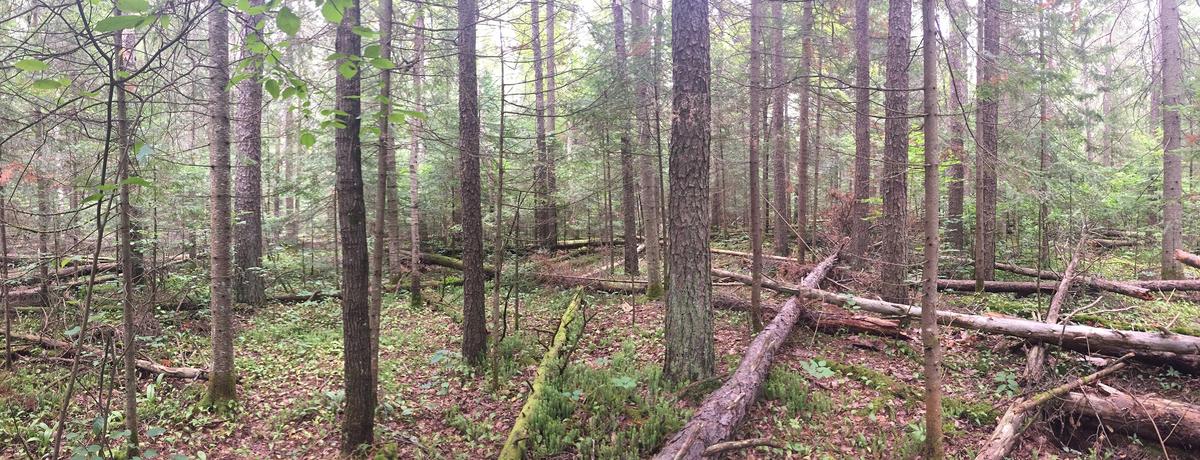Overview
In 1925, Randolph Milton Brown designed a thinning experiment with two treatment levels and a control within a 27-year old stand of jack pine. The experiment was designed to continue research that had begun with a 1912-1914 thinning of a 37-year-old jack pine stand, an installation that lacked a control. The 1925 thinning included a ‘heavy’ thinning, a ‘moderate’ thinning, and a ½ acre “check plot” control. The stand was continuously monitored for growth and yield until 1960, at which point it was effectively abandoned. The experiment resulted in two publications by Thorvald Schantz-Hanson, in 1931 and 1937, regarding the growth and yield, and ecological effects of the thinning respectively.
In 2015, Mike Reinikainen proposed a study based on the 1925 thinning, which was installed as a set of three replicated of three pre-commercial thinning treatments and a control in 2003 salvage-harvest origin (ice storm damage) jack pine stands.
Silviculture Objective(s)
Objectives were to determine the effect of different pre-commercial thinning strategies on naturally regenerating jack pine stands. In 1925, primary interest was concentrated on short-term yield improvement (results published in 1931).
In 2015, interest was in assessing the effect of thinning on growth rate, form, and damaging agents such as Peridermium harknessii (pine-pine gall rust) and Cronartium comptoniae (sweet fern rust).
Pre-treatment stand description and condition
Stand establishment and management history:
1925 Study: stand established as naturally regenerating jack pine after 1894 fire. No management actions taken after 1925
2015 Study: stand established as naturally regenerating jack pine after ice storm/salvage logging in 2001. No further management actions after 2015
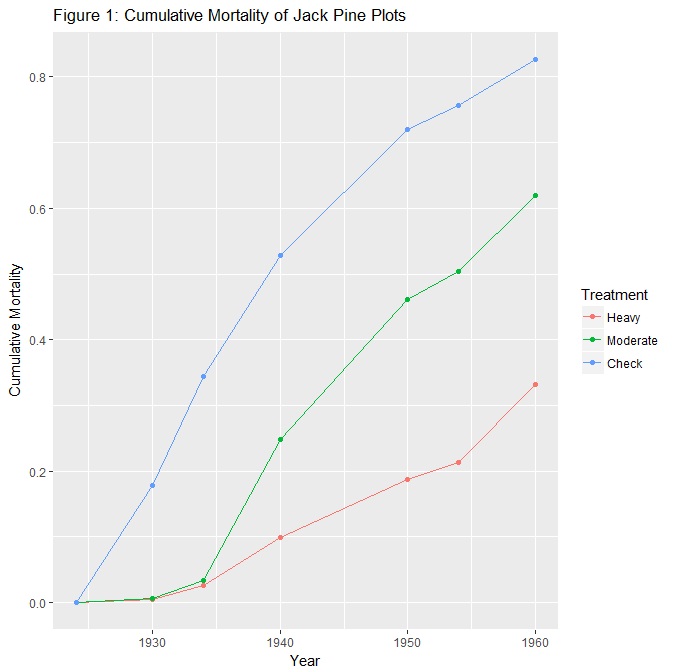
Figure 1: Cumulative mortality of jack pine plots.
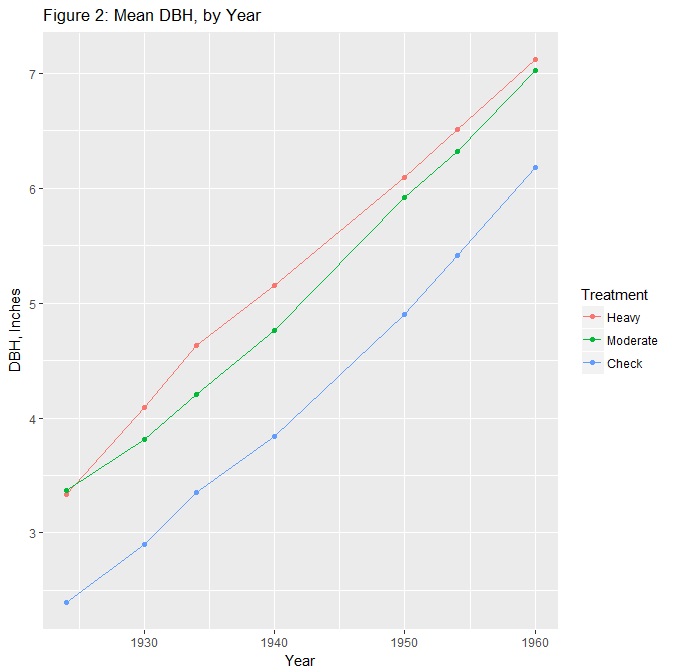
Figure 2: Mean DBH by year through 1960.
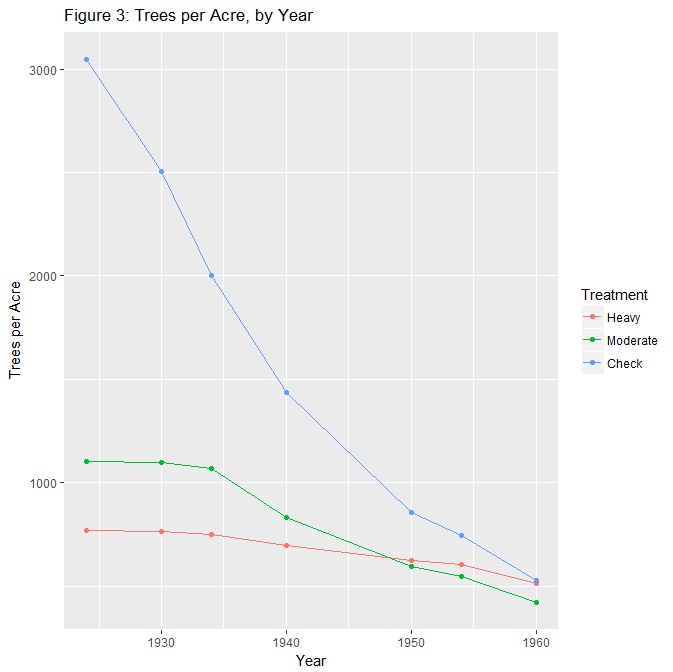
Figure 3: Trees per acre by year, through 1960.
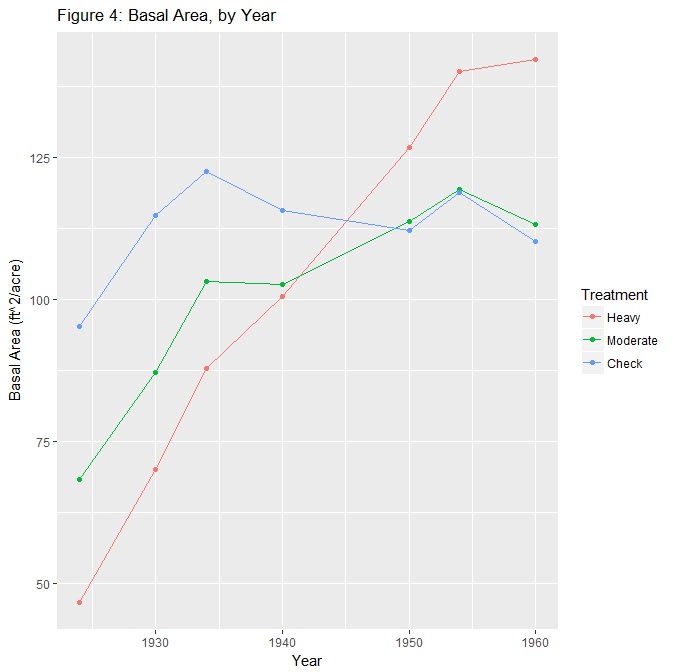
Figure 4: Basal area by year, through 1960
Pre-treatment species composition:
Jack pine is only species recorded, understory consistent with FDn32c1 recorded in 1925
Pre-treatment growth and stocking:
1925: between 2200-3040 stems/ac
2015: >3000 stems/ac
Pre-treatment forest health issues:
1925: none recorded
2015: Peridermium harknessii (pine-pine gall rust), Cronartium comptoniae (sweet fern rust), Erethizon dorsatum (porcupine) and Pissodes strobe (white pine weevil)
Silviculture Prescription
In 1925: three plots were established- a ½ acre plots were to be thinned to approximate spacing of 8x8ft, a 4/10 acre plot to be thinned to approximately 6x6ft, and a1/4 acre check plot left unthinned. A 30 ft buffer was established around each plot, receiving the same treatment, and plots were marked with corner stakes. Trees of good form were preferentially left at approximately the spacing specified, and then marked with tin tags at approximately breast height.
In 2015, LiDAR was used to identify three areas of similar characteristics for the replicates. Spacings of 9x9ft, 7x7ft, and 5x5ft were planned, along with a control. Trees with signs of damage due to pathogen or animal attack were preferentially marked for removal, and trees of good form were preferentially retained. 1/20 acre plots were established at the center of each treatment area, and 1/40 acre plots were established in each control area. Plots were marked with center stakes, and trees were tagged at DBH.
What actually happened during the treatment
1925: Trees were thinned with the aforementioned criteria, presumably by students, yielding the following results:
| Plot | Age (1925) | Stems/ac (before) | Removed | Stems/ac (after) | Percent Removed | Approx. spacing (ft) |
|---|---|---|---|---|---|---|
|
6 |
27 |
2478 |
1710 |
768 |
69 |
8x8 |
|
7 |
27 |
2230 |
1125 |
1105 |
50 |
6x6 |
|
Check |
27 |
3040 |
0 |
3040 |
0 |
- |
2015: Members of the Conservation Corps, the University of Minnesota Forestry Club, and CFC staff completed the pre-commercial thinning with the following results:
| REP | TRT | TPA | Actual Spacing (ft) | BA/ Acre | AVG DBH (in) | AVG HT (ft) | AVG LCR | % PP Rust | % SF Rust | % Dead top | % Porcupine | % affected |
|---|---|---|---|---|---|---|---|---|---|---|---|---|
|
1 |
D |
700 |
7.9 |
32.3 |
2.8 |
18.5 |
62% |
17% |
6% |
3% |
0% |
26% |
|
1 |
C |
780 |
7.5 |
38.7 |
2.9 |
20.3 |
60% |
0% |
0% |
23% |
8% |
28% |
|
1 |
B |
1500 |
5.4 |
54.4 |
2.5 |
19.4 |
57% |
31% |
12% |
16% |
3% |
53% |
|
1 |
A |
1840 |
4.9 |
65.1 |
2.5 |
19.3 |
55% |
20% |
4% |
9% |
11% |
39% |
|
2 |
D |
660 |
8.1 |
30.9 |
2.9 |
19.2 |
60% |
21% |
0% |
6% |
0% |
27% |
|
2 |
C |
860 |
7.1 |
38.0 |
2.8 |
19.9 |
57% |
5% |
0% |
0% |
5% |
7% |
|
2 |
B |
1380 |
5.6 |
49.3 |
2.5 |
19.8 |
59% |
14% |
0% |
3% |
0% |
19% |
|
2 |
A |
1640 |
5.2 |
69.5 |
2.6 |
17.4 |
62% |
12% |
0% |
5% |
7% |
22% |
|
3 |
D |
640 |
8.3 |
25.8 |
2.6 |
19.0 |
54% |
19% |
0% |
0% |
0% |
19% |
|
3 |
C |
920 |
6.9 |
28.6 |
2.3 |
18.2 |
59% |
22% |
9% |
9% |
11% |
46% |
|
3 |
B |
1360 |
5.7 |
55.1 |
2.6 |
20.6 |
59% |
37% |
4% |
16% |
3% |
53% |
|
3 |
A |
2280 |
4.4 |
79.2 |
2.4 |
19.2 |
58% |
16% |
0% |
25% |
5% |
44% |
Replicates: 1: Geno Hwy; 2: Kochs Road; 3: Old Road
Treatments: D: 9x9; C: 7x7; B: 5x5; A: Control
Post-treatment assessment
1925: A paper published by Thorvald Schantz-Hanson in 19311, with data collected in 1930 representing 5 years of growth since the initial treatment, noted favorable increases in individual tree yield in the heavily thinned plot, but no improvement in overall yield at that time. The paper noted that at the time of publication, such a pre-commercial thinning of jack pine would not be economically in most silvicultural environments. By 1945, however, a mention in Technical Bulletin 1712 noted that the heavily thinned stand increased growth and improved structure. Individual tree data continued to be collected up to 1960, although no further publications resulted from this experiment. The data presented shows the continued improvement of the heavily thinned plot over the other plots in terms of cumulative mortality, mean DBH, stems per acre, and basal area (Figs. 1, 2, 3, & 4, respectively). The author visited these plots in August 2016, and noted considerable visible difference in the forest environment, as well as measurable differences in surviving basal area of jack pine. The heavily-thinned stand was more open, with minimal hazel or other understory shrubs, and few understory balsams. The moderately thinned plot had a fair amount of balsam regeneration, but had also visibly been affected by a wind event. The check plot was thick with balsam (>350/ac, >1in DBH) regeneration, and had only one living jack pine in the measured area.
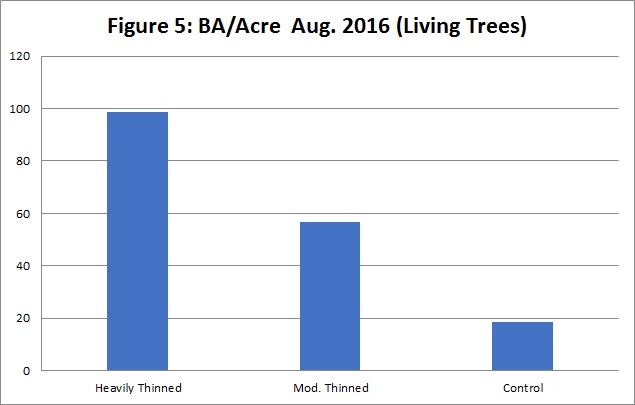
Figure 5: Basal area per acre in 2016
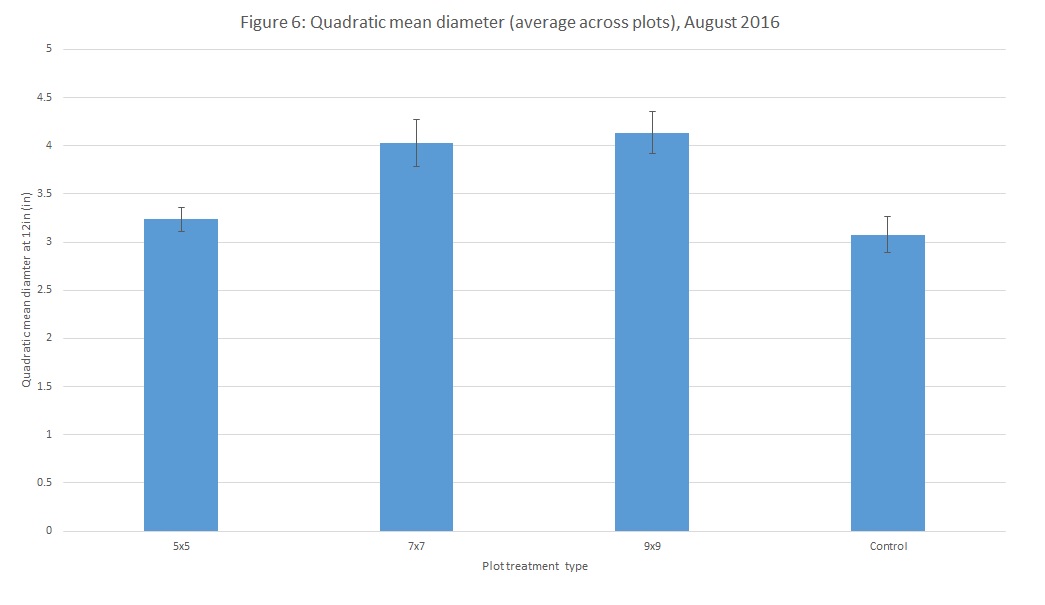
Figure 6: Quadratic mean DBH in 2016.
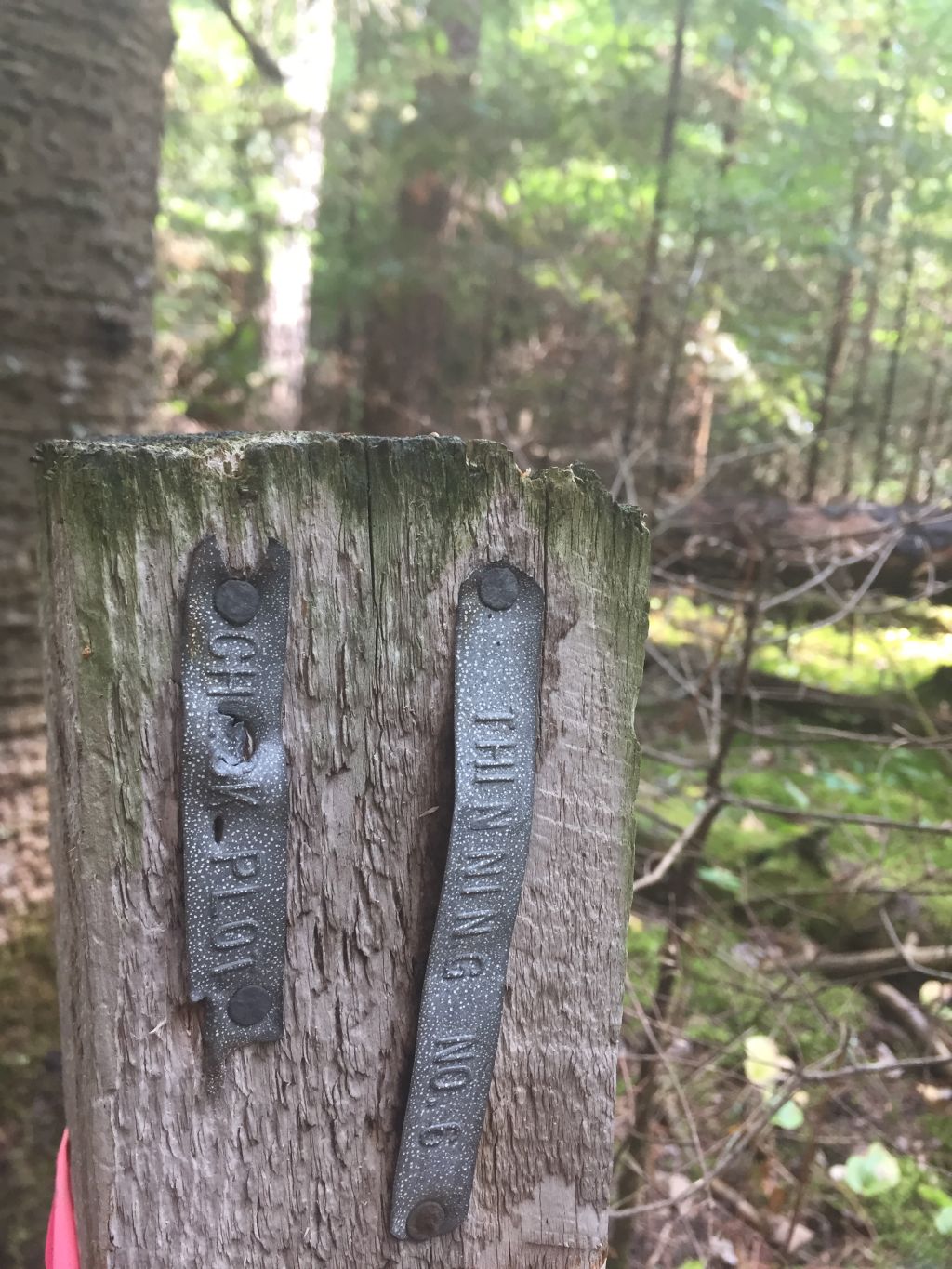
Figure 7: Control stand corner.
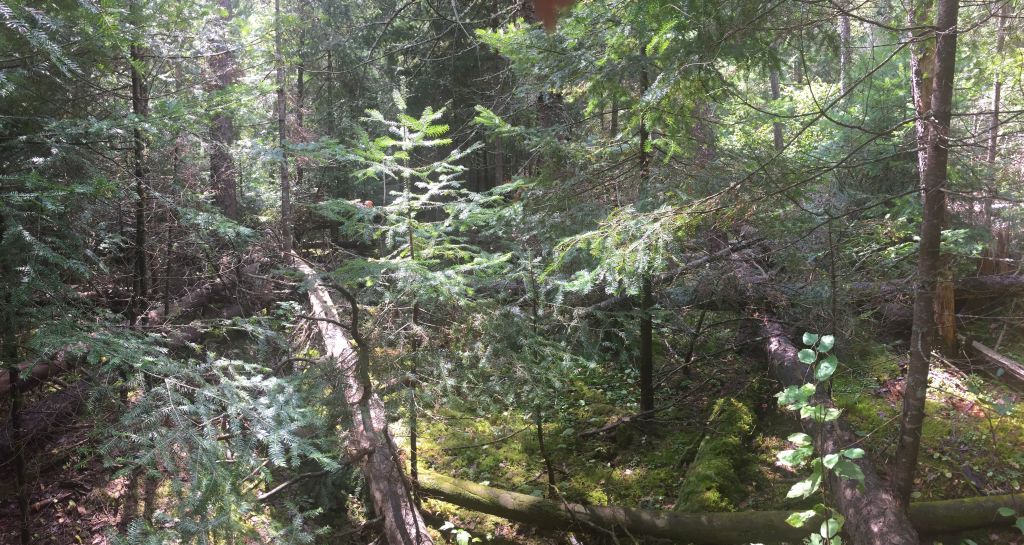
Figure 8: Control stand corner.
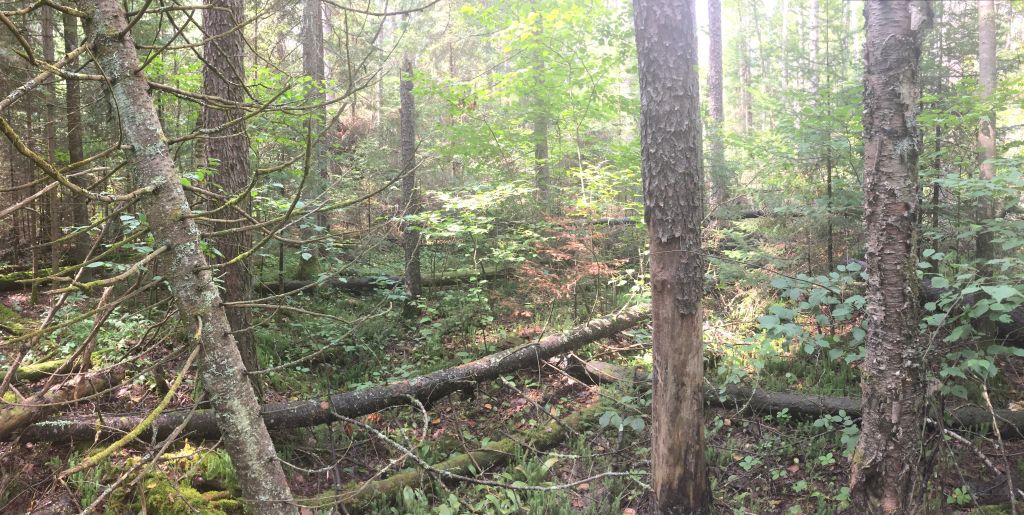
Figure 9: Moderate thinning.
2015: Measurements were taken of DBH by a group of undergraduate forestry students at the Cloquet Field Session in August of 2016. They determined that after 1 year, there was a statistically significant (P<0.05) difference between the control plots and the 7x7ft thinned plots, but no significant difference between the 7x7ft and 9x9ft thinnings (Fig.6). Measurements are scheduled to continue in 2018, 2020, 2025, and 2050 before scheduled final harvest in that year.
References:
1Schantz-Hansen, Thorvald. "Some Results of Thinning 27-Year Old Jack Pine." Journal of Forestry 26 (1931): 544-550.
2Allison, J. H., and R. M. Brown. Mangement of the Cloquet Forest: Second Ten-Year Period. University of Minnesota Agricultural Experiment Station, 1945.
Plans for future treatments
Currently, no further treatments are scheduled for these two sets of experimental plots. The location of the 1925 experiment has been designated as a teaching site, and serves as a demonstration of the successive trajectory of an unmanaged jack pine stand. If time and staffing allow, a re-measurement of the 1925 plots along the lines of the original measurement regime would be ideally completed in the next few years.
Costs and economic considerations
1925: Estimated costs of $4-13/acre ($58-$181 inflation adjusted for 2017), or 10.5-35 hours of labor/acre for thinning (37 ½ cents per hour is the reported wage), the removed material was specifically noted to be non-merchantable. At the time, this was considered to be a non-economically feasible silvicultural prescription for jack pine.
2015: Thinning was conducted primarily by volunteers and students, and no cost data is available for the planning, marking tags, and stakes.
Summary / lessons learned / additional thoughts
The results of the 1925 thinning are interesting, but clearly the expectations of replication were different when it was installed, so it is difficult to draw conclusive lessons from the data. The 2015 installation seeks to remedy this oversite by providing three replications; however, results on the time-scale of the previous work will not be available until 2050.
Taken as an experiment in the long-term forest health effects of a pre-commercial thinning on jack pine, the 1925 study suggests that thinning has much broader effects than simply improving timber value, and that even in a 120 year-old stand, which has experienced significant mortality of jack pine, thinning can effect stand trajectory.
Submitted by
Kyle Gill
Kyle has been the CFC forest manager and research coordinator since 2015. He enjoys exploring stand development, silviculture, and the inherent biases that we bring to decision making. He feels it is important to see himself and other humans as community members of forested and non-forested ecological communities.
